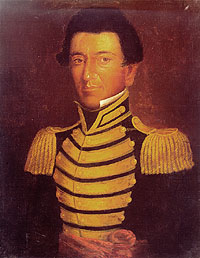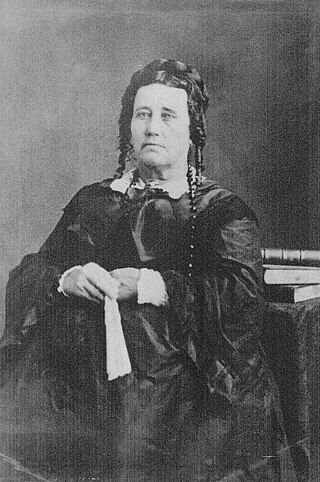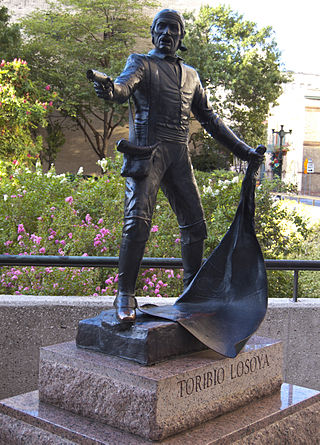Related Research Articles

David Crockett was an American folk hero, frontiersman, soldier, and politician. He is often referred to in popular culture as the "King of the Wild Frontier". He represented Tennessee in the U.S. House of Representatives and served in the Texas Revolution.

The Alamo is a historic Spanish mission and fortress compound founded in the 18th century by Roman Catholic missionaries in what is now San Antonio, Texas, United States. It was the site of the Battle of the Alamo in 1836, a pivotal event of the Texas Revolution in which American folk heroes James Bowie and Davy Crockett were killed. Today it is a museum in the Alamo Plaza Historic District and a part of the San Antonio Missions World Heritage Site.
William Barret "Buck" Travis was a 19th-century American lawyer and soldier. He is known for helping set the Texas Revolution in motion during the Anahuac disturbances and commanding the Misión San Antonio de Valero as a lieutenant colonel in the Texian Army.

James Bowie was a 19th-century American pioneer, slave smuggler and trader, and soldier who played a prominent role in the Texas Revolution. He was among the Americans who died at the Battle of the Alamo. Stories of him as a fighter and frontiersman, both real and fictitious, have made him a legendary figure in Texas history and a folk hero of American culture.

The Battle of the Alamo was a pivotal event and military engagement in the Texas Revolution. Following a 13-day siege, Mexican troops under President General Antonio López de Santa Anna reclaimed the Alamo Mission near San Antonio de Béxar, killing most of the occupants. Santa Anna's refusal to take prisoners during the battle inspired many Texians and Tejanos to join the Texian Army. Motivated by a desire for revenge, as well as their written desire to preserve a border open to immigration and the importation and practice of slavery, the Texians defeated the Mexican Army at the Battle of San Jacinto, on April 21, 1836, ending the conquering of the Mexican state of Coahuila y Tejas by the newly formed Republic of Texas.

James Walker Fannin Jr. was an American military officer, planter and slave trader who served in the Texian Army during the Texas Revolution. After being outnumbered and surrendering to the Mexican Army at the Battle of Coleto Creek, Fannin and his fellow prisoners of war were massacred soon afterward at Goliad, Texas, under Antonio López de Santa Anna's orders. He was memorialized in several place names, including a military training camp and a major city street in Houston.

Juan Nepomuceno Seguín was a Spanish-Tejano political and military figure of the Texas Revolution who helped to establish the independence of Texas. Numerous places and institutions are named in his honor, including the county seat of Seguin in Guadalupe County, the Juan N. Seguin Memorial Interchange in Houston, Juan Seguin Monument in Seguin, World War II Liberty Ship SS Juan N. Seguin, Seguin High School in Arlington.

The Alamo is a 1960 American epic historical war film about the 1836 Battle of the Alamo produced and directed by John Wayne and starring Wayne as Davy Crockett. The film also co-stars Richard Widmark as Jim Bowie and Laurence Harvey as William B. Travis, and features Frankie Avalon, Patrick Wayne, Linda Cristal, Joan O'Brien, Chill Wills, Joseph Calleia, Ken Curtis, Ruben Padilla as Santa Anna, and Richard Boone as Sam Houston. Shot in 70 mm Todd-AO by William H. Clothier, it was released by United Artists.
Louis "Moses" Rose, sometimes written as Lewis Rose, was according to Texas legend the only man who chose to leave the besieged Alamo in 1836, rather than fight and die there. He was illiterate and many believe that his tale was embellished by those who were writing on his behalf. Some question the accuracy of this part of the legend.
The Grass Fight was a small battle during the Texas Revolution, fought between the Mexican Army and the Texian Army. The battle took place on November 26, 1835, just south of San Antonio de Béxar in the Mexican region of Texas. The Texas Revolution had officially begun on October 2 and by the end of the month the Texians had initiated a siege of Béxar, home of the largest Mexican garrison in the province. Bored with the inactivity, many of the Texian soldiers returned home; a smaller number of adventurers from the United States arrived to replace them. After the Texian Army rejected commander-in-chief Stephen F. Austin's call to launch an assault on Béxar on November 22, Austin resigned from the army. The men elected Edward Burleson their new commander-in-chief.

Susanna Wilkerson Dickinson and her infant daughter, Angelina, were among the few American survivors of the 1836 Battle of the Alamo during the Texas Revolution. Her husband, Almaron Dickinson, and 185 other Texian defenders were killed by the Mexican Army.
Juana Gertrudis Navarro Alsbury was one of the few Texian survivors of the Battle of the Alamo during the Texas Revolution in 1836. As Mexican forces entered her hometown, San Antonio de Bexar, on February 23, Alsbury's cousin by marriage, James Bowie, brought her with him to the Alamo Mission so that he could protect her. Bowie, the co-commander of the Texian forces, collapsed from illness on the second day of the siege; Alsbury nursed him throughout the remainder of the siege. On March 4, Texian co-commander William Barret Travis sent her as an emissary to Mexican commander Antonio Lopez de Santa Anna to negotiate an honorable surrender for the Texian forces. She made no headway, and her visit likely increased Santa Anna's impatience to end the siege in a spectacular fashion. Santa Anna launched an early-morning assault on the Alamo on March 6.
Francisco Antonio Ruiz was the alcalde of San Antonio during the Texas Revolution and was responsible for identifying the bodies of those killed at the Battle of the Alamo.
Almaron Dickinson was a Texian soldier and defender during the Battle of the Alamo, fought during the Texas Revolution. Dickinson is best known as the artillery officer of the small garrison, and the husband of one of the few non-Mexican survivors to live through the battle, Susanna Dickinson, as well as the father to their infant daughter Angelina, whose life was also spared. He is a member of the Immortal 32 and Old Eighteen.
John William Smith was a Republic of Texas and American political figure, the first mayor of San Antonio under the Republic, and the first mayor of San Antonio under the state of Texas. He supported and served Texas during the struggle for Texas Independence.

The City of San Antonio is one of the oldest Spanish settlements in Texas and was, for decades, its largest city. Before Spanish colonization, the site was occupied for thousands of years by varying cultures of indigenous peoples. The historic Payaya Indians were likely those who encountered the first Europeans.
Salvador Flores served as a volunteer in the Texan Army in 1835–1836. He was instrumental in organizing and commanding Texian volunteers in support of the Texas Revolution. He participated in many battles and would rise through the ranks to reach Captain status during the fight for Texas independence from Mexico. Salvador continued to provide protection for the ranches and settlers of Texas throughout the Republic years.

José Toribio Losoya, was a former Mexican soldier, a Texian military participant in the Siege of Bexar and Battle of the Alamo defender.

The Alamo Cenotaph, also known as The Spirit of Sacrifice, is a monument in San Antonio, Texas, United States, commemorating the Battle of the Alamo of the Texas Revolution, which was fought at the adjacent Alamo Mission. The monument was erected in celebration of the centenary of the battle, and bears the names of those known to have fought there on the Texas side.
References
- ↑ Battle of the Alamo
- ↑ "The Defenders – William R. Carey". The Alamo. Retrieved 2016-05-02.
- ↑ List of Alamo defenders